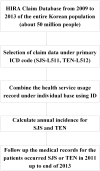Incidence of Stevens-Johnson Syndrome and Toxic Epidermal Necrolysis: A Nationwide Population-Based Study Using National Health Insurance Database in Korea
- PMID: 27835661
- PMCID: PMC5106005
- DOI: 10.1371/journal.pone.0165933
Incidence of Stevens-Johnson Syndrome and Toxic Epidermal Necrolysis: A Nationwide Population-Based Study Using National Health Insurance Database in Korea
Abstract
Background: Stevens-Johnson syndrome (SJS) and toxic epidermal necrolysis (TEN) are life-threatening diseases; however, it is hard to estimate their incidence due to the rarity of these diseases. We evaluated the incidence of SJS and TEN using a nationwide administrative database.
Methods: We used a national medical insurance review system (Health Insurance Review and Assessment) database which contained the claim data of the entire nation from 2009 to 2013 to estimate the accurate incidence of SJS and TEN in Korea. The diagnostic codes of L511 (SJS) or L512 (TEN) from the International Classification of Diseases-10th revision were used to define the target study population. We also retrospectively followed up a 2011 SJS and TEN cohort for 24 months in order to assess the in-hospital mortality, related complications and total claims cost due to SJS and TEN.
Results: A total of 1,167 (938 SJS and 229 TEN) cases were newly diagnosed from 2010 to 2013. The age- and sex-standardized annual incidences estimated in this study were 3.96 to 5.03 in SJS and 0.94 to 1.45 in TEN per million. There was no significant change in annual incidence throughout the study periods. When analyzed by 10-year age groups, the annual incidence was the lowest in group 20-29 years and the highest in group 70 for both SJS and TEN. Based on the 2011 cohort analysis, the in-hospital mortality were 5.7 and 15.1% for SJS and TEN, respectively. The mortality increased with age, particularly, after 40 years of age. Among the complications related with SJS or TEN, ocular sequelae was the most common (43.1 and 43.4% of SJS and TEN patients, respectively) followed by urethral sequelae (5.7 and 9.4% of SJS and TEN patients, respectively).
Conclusion: Overall, our data suggest that SJS, and TEN are infrequent but constantly arise throughout the years.
Conflict of interest statement
The authors have declared that no competing interests exist.
Figures



References
-
- Roujeau JC, Guillaume JC, Fabre JP, Penso D, Flechet ML, Girre JP. Toxic epidermal necrolysis (Lyell syndrome). Incidence and drug etiology in France, 1981–1985. Arch Dermatol 1990;126:37–42. - PubMed
-
- Schopf E, Stuhmer A, Rzany B, Victor N, Zentgraf R, Kapp JF. Toxic epidermal necrolysis and Stevens-Johnson syndrome. An epidemiologic study from West Germany. Arch Dermatol 1991;127:839–42. - PubMed
-
- Rzany B, Mockenhaupt M, Baur S, Schröder W, Stocker U, Mueller J, et al. Epidemiology of erythema exsudativum multiforme majus, Stevens-Johnson syndrome, and toxic epidermal necrolysis in Germany (1990–1992): Structure and results of a population-based registry. J Clin Epidemiol 1996;49:769–773. - PubMed
-
- Chan HL, Stern RS, Arndt KA, Arndt KA, Langlois J, Jick SS, et al. The incidence of erythema multiforme, Stevens-Johnson syndrome, and toxic epidermal necrolysis. A population-based study with particular reference to reactions caused by drugs among outpatients. Arch Dermatol 1990;126:43–7. - PubMed
MeSH terms
LinkOut - more resources
Full Text Sources
Other Literature Sources

